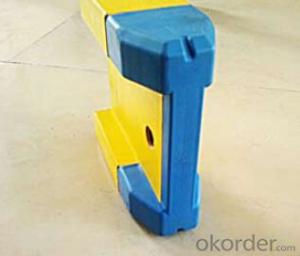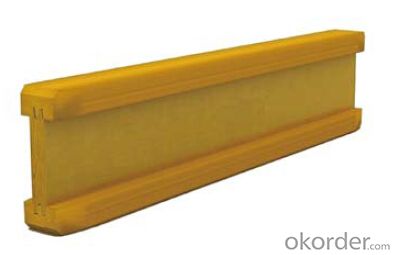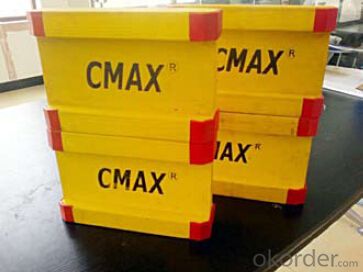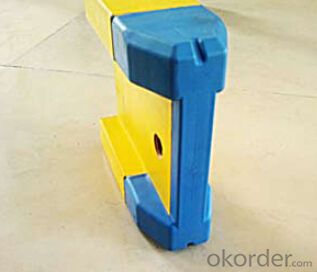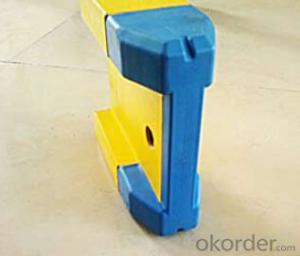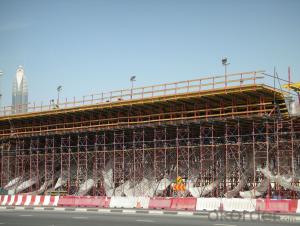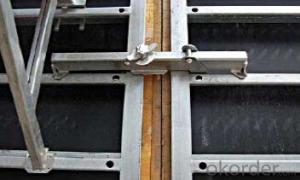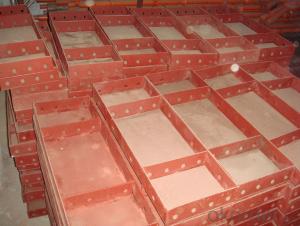Timber-beam Formwork for Building Construction
- Loading Port:
- Tianjin
- Payment Terms:
- TT OR LC
- Min Order Qty:
- 50 m²
- Supply Capability:
- 1000 m²/month
OKorder Service Pledge
Quality Product, Order Online Tracking, Timely Delivery
OKorder Financial Service
Credit Rating, Credit Services, Credit Purchasing
You Might Also Like
Characteristics:
◆ Standardized production lines.
Supply capability: 3000m/day, Lmax = 6600mm.
◆ Finger jointing of the flange and web, the strength of timber beam is highly improved.
Max. shearing force failure load:40KN
◆ Well treated to prevent from water penetration or erosion, so the service life maximally
extended.
Normally, CNBM timber beam H20 can be used for 4 to 5 years, the exact using time would
depend on maintenance & storage.
◆ Robust caps at the end of the girders protect against damages.
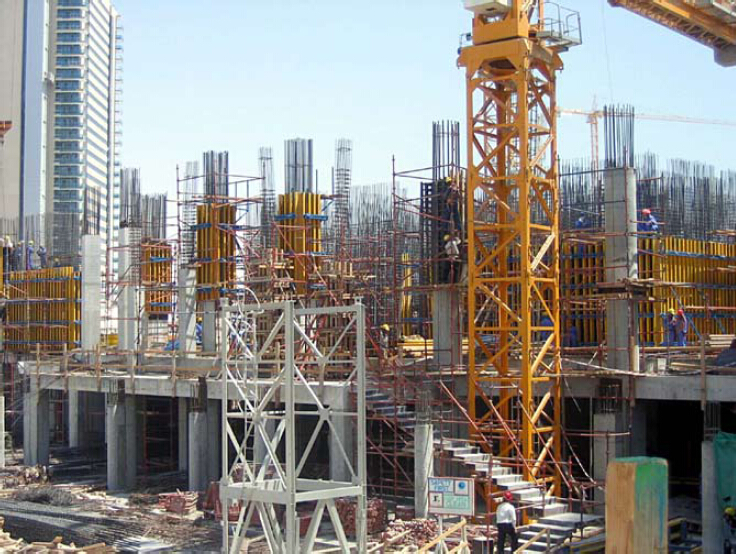
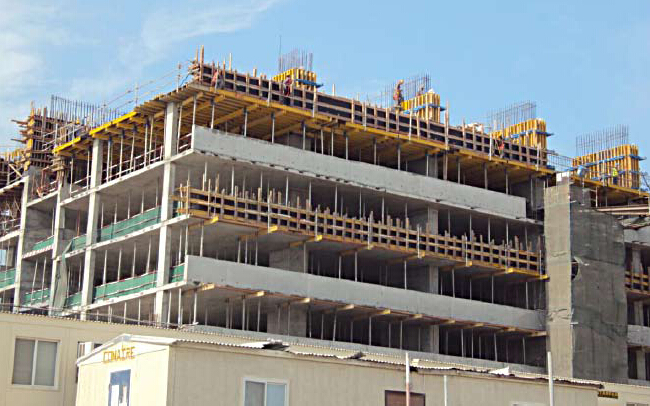
- Q: How does steel formwork handle formwork repositioning?
- Steel formwork is highly durable and flexible, making it ideal for handling formwork repositioning. Its sturdy construction allows for easy dismantling, transportation, and reassembly in new locations. Steel formwork systems typically consist of modular panels that can be easily adjusted and reconfigured to accommodate different shapes and sizes of concrete structures. This versatility and adaptability make steel formwork a preferred choice in construction projects where formwork repositioning is required.
- Q: What are the challenges of using steel formwork?
- One of the main challenges of using steel formwork is its high initial cost compared to other types of formwork. Steel formwork also requires skilled labor for its installation and removal, which can increase project expenses. Additionally, steel formwork is heavy and requires special transportation and handling equipment, making it less convenient and cost-effective for small-scale projects. Finally, steel formwork requires proper maintenance to prevent corrosion and ensure its longevity, adding to the overall cost and effort involved in its use.
- Q: What are the safety considerations when working with steel formwork?
- When working with steel formwork, there are several safety considerations that should be taken into account. First and foremost, workers must ensure that the formwork is properly installed and secured to prevent any collapse or instability. It is essential to follow manufacturer's instructions and guidelines for assembly and disassembly. Additionally, workers should be equipped with proper personal protective equipment (PPE) such as hard hats, gloves, and safety glasses to protect themselves from potential hazards such as falling objects or metal shards. Adequate training and supervision are also crucial to ensure that workers are aware of the potential risks and hazards associated with steel formwork and know how to work safely. Regular inspections of the formwork should be conducted to identify any signs of damage or deterioration that could compromise its structural integrity. Finally, proper communication and coordination among the team members is essential for a safe working environment when using steel formwork.
- Q: Can steel formwork be used in high-rise construction?
- Yes, steel formwork can be used in high-rise construction. Steel formwork offers high strength and durability, making it suitable for withstanding the high pressures and loads experienced in tall buildings. It also provides excellent dimensional accuracy, allowing for precise construction and ensuring the structural integrity of the high-rise building. Furthermore, steel formwork can be easily assembled and disassembled, making it a time-efficient choice for large-scale projects.
- Q: What are the different types of formwork corners used in steel formwork systems?
- Various types of formwork corners are utilized in steel formwork systems to create different shapes and angles during the construction process. These corners are specifically designed to offer stability, support, and flexibility when shaping concrete structures. The most common types of formwork corners used in steel formwork systems include the following: 1. External 90-Degree Corner: This particular corner is implemented to form a right angle or 90-degree corner in the formwork. It typically consists of interconnected and reinforced steel plates and angles to provide strength and stability. External 90-degree corners find frequent usage in constructing walls, columns, and beams. 2. Internal 90-Degree Corner: Similar to the external 90-degree corner, the internal 90-degree corner is employed to create a right angle or 90-degree corner in the formwork. However, it is designed to be placed within the formwork, resulting in a smooth finish on the exposed concrete surface. Internal 90-degree corners are commonly employed in walls, columns, and other structures where a clean finish is desired. 3. Adjustable Corner: When there is a requirement for various angles and shapes within the formwork, an adjustable corner comes into play. It comprises adjustable steel plates and angles that can be positioned and securely locked to achieve the desired shape and angle. Adjustable corners are versatile and can be utilized in curved walls, sloping structures, and irregular shapes. 4. Chamfered Corner: A chamfered corner is utilized to create a beveled or chamfered edge on the concrete structure. It typically consists of steel plates and angles that are positioned to form a specific angle or bevel. Chamfered corners are commonly employed in architectural applications to create decorative edges, enhance the structure's appearance, and facilitate a smooth transition between different elements. 5. Rounded Corner: A rounded corner is implemented to create a curved or rounded edge in the concrete structure. It is typically made of steel plates and angles that are bent or shaped to achieve the desired curve or radius. Rounded corners are frequently utilized in architectural applications, such as curved walls, arches, and other curved elements, to create visually appealing and unique designs. These examples represent only a few of the diverse types of formwork corners used in steel formwork systems. The selection of a specific corner type hinges on the desired shape, angle, and finish of the concrete structure being formed. It is crucial to choose the appropriate formwork corner to ensure the integrity and quality of the construction project.
- Q: How does steel formwork compare to other formwork materials in terms of cost?
- Compared to timber or plywood, steel formwork generally carries a higher price tag. However, when considering the overall expenses of a construction project, steel formwork has the potential to save costs in the long run. Although the initial cost of steel formwork may be greater, it boasts exceptional durability and can be reused multiple times without compromising its structural integrity. This reusability feature diminishes the need for constant replacement or repair, ultimately reducing the overall expenses for formwork materials in the long term. Furthermore, steel formwork provides unparalleled strength, stability, and precision in shaping concrete structures, resulting in a superior final product. This, in turn, can lead to reduced labor expenses and shorter construction durations, effectively counterbalancing the initial investment in steel formwork. Moreover, steel formwork offers heightened safety due to its fire-resistant properties and ability to withstand extreme weather conditions. This lowers the chances of accidents or damage during the construction process, which can potentially result in savings on insurance costs. Although steel formwork may initially be more costly than alternative materials, it offers a multitude of advantages that can lead to cost savings throughout the entirety of the construction process.
- Q: What are the common cost implications of using steel formwork in a construction project?
- The common cost implications of using steel formwork in a construction project include higher initial costs compared to other formwork materials, such as wood or plastic. However, steel formwork offers durability and can be reused multiple times, reducing the overall cost of formwork over the long term. Additionally, steel formwork provides better quality and accuracy in concrete finishing, saving costs on rework or repairs.
- Q: Can steel formwork be used for architectural concrete walls?
- Yes, steel formwork can be used for architectural concrete walls. Steel formwork provides a strong and durable framework that can withstand the pressure of wet concrete and result in smooth and precise finishes. It is commonly used for complex shapes and designs in architectural concrete walls as it allows for flexibility and ease of construction.
- Q: How does steel formwork affect the overall construction site dust control?
- The utilization of steel formwork has a positive influence on dust control at construction sites. In comparison to alternative formwork materials like wood or plastic, steel formwork is more enduring and less prone to deterioration or breakage, leading to the generation of dust particles. Consequently, the construction process will produce less dust. Moreover, steel formwork is typically constructed to fit tightly together, reducing the presence of gaps and spaces where dust can gather. This outcome creates a cleaner and more regulated environment at the construction site since there are fewer areas for dust to settle and become airborne. Additionally, steel formwork is reusable, minimizing the necessity for frequent replacements. Consequently, the amount of waste generated, including dust-producing debris from removing and replacing formwork, is reduced. In summary, the adoption of steel formwork plays a significant role in enhancing dust control at construction sites, thereby fostering a safer and healthier work environment for laborers and decreasing the potential adverse effects of dust on nearby communities and the environment.
- Q: How does steel formwork affect the overall durability of a structure?
- The durability of a structure can be greatly influenced by steel formwork. Steel formwork is known for its strength and durability, which provides excellent support and stability during the construction process. This ensures accurate construction according to required specifications, which is vital for long-term durability. Using steel formwork offers several advantages. It has the ability to withstand high pressures and loads, which is especially important in large-scale construction projects involving heavy concrete pours. The steel formwork effectively distributes the weight and pressure exerted by the concrete, preventing any deformation or collapse. This helps maintain the structure's integrity and durability over time. In addition, steel formwork is highly resistant to environmental factors such as moisture, humidity, and temperature changes. This resistance protects the structure from potential damage such as corrosion, rot, or warping, enhancing its overall durability. This reduces the need for expensive repairs or maintenance. Furthermore, steel formwork provides a smooth and even surface for the concrete to adhere to during the curing process. This results in a uniform and consistent finish, reducing the risk of cracks or weak points in the structure. This absence of defects improves the structure's durability, as it is less prone to structural weaknesses that can compromise its integrity over time. Moreover, steel formwork is reusable and can be easily dismantled and reassembled for multiple construction projects. This not only reduces construction costs but also minimizes waste and environmental impact. The ability to reuse steel formwork ensures consistent use of high-quality materials, contributing to the structure's long-term durability. In conclusion, steel formwork plays a significant role in determining the overall durability of a structure. Its strength, resistance to environmental factors, ability to distribute loads, and provision of a uniform finish all contribute to the long-term durability and structural integrity of the building. By utilizing steel formwork, builders can ensure that the structure is built to last, minimizing the need for future repairs or replacements.
Send your message to us
Timber-beam Formwork for Building Construction
- Loading Port:
- Tianjin
- Payment Terms:
- TT OR LC
- Min Order Qty:
- 50 m²
- Supply Capability:
- 1000 m²/month
OKorder Service Pledge
Quality Product, Order Online Tracking, Timely Delivery
OKorder Financial Service
Credit Rating, Credit Services, Credit Purchasing
Similar products
Hot products
Hot Searches


